Persons, Collections and Topics
The Hunt Institute is committed to making its collections accessible for research. To that end, we are digitizing materials as staff time, item condition and copyright law permit. We are pleased to offer descriptions of and in some cases digitized versions of the following books and special botanical collections from the Library.

Adanson Library
The Michel Adanson Library at Hunt Institute includes the botanical portion of Adanson's personal library, along with correspondence, manuscripts, and a large number of plant illustrations clipped from published sources. Roy A. Hunt purchased this collection for the Hunt Botanical Library in 1961, making additional purchases in 1962. As catalogued in our publication, Adanson: The Bicentennial of Michel Adanson's "Familles des Plantes" (1963–1964), the collection contains 127 book titles, 117 letters, 146 manuscripts and thousands of plant images clipped from published works, many of them annotated by him.
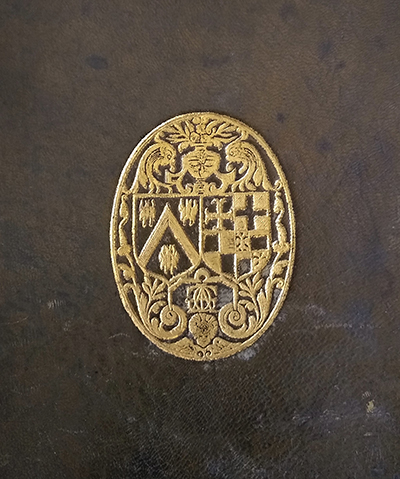
Armorial bindings
Finding an armorial binding in the collection and identifying its previous owners is always a thrill. (At some point we will have found them all and will have to move on to armorial bookplates.) Equally thrilling is finding other provenance markings that show further steps on the book's path to the Library at Hunt Institute. Often these secondary provenance markings are more pertinent to the field of botany in that they are frequently the marks of naturalists or botanists. This sampling of armorial bindings includes those and others of interest while some remain a mystery.
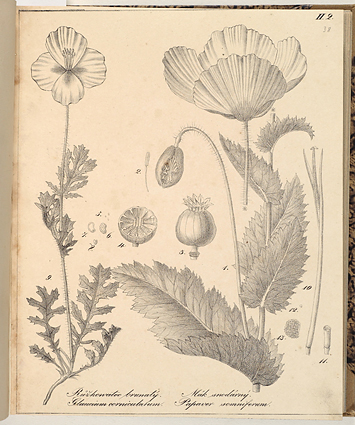
Berchtold and Presl (1823–1835)
The Library has digitized Friedrich von Berchtold (1781–1876) and Jan Svatopluk Presl (1791–1849), O Prirozenosti Rostlin aneb Rostlinár ... (Prague, Jos. Krause, 1823–1835), except for the text to volume 3, lacking in our copy. Bohemian botanists Berchtold and Presl co-authored two works that have importance for botanists today working on problems of taxonomy and nomenclature. The first was O Prirozenosti Rostlin (Prague, Krala Wiljma Endersa, 1820), which treated vascular plant families. The second was O Prirozenosti Rostlin aneb Rostlinár (Prague, Jos. Krause, 1823–1835). At the time these works were written, their impact was limited by their being published in Czech rather than in Latin, but the work of Berchtold and Presl has been gaining new attention in the West in recent decades.
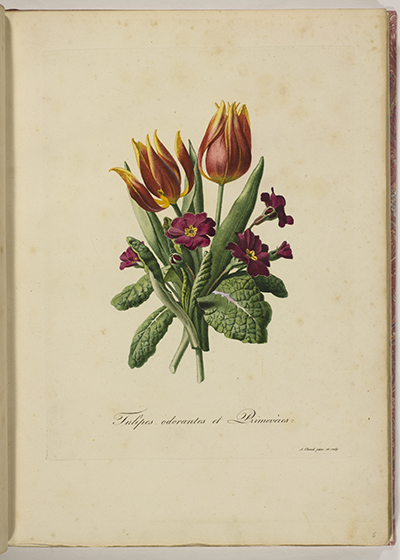
Chazal, Flore Pittoresque (1818–?1825)
The Library has digitized Flore Pittoresque Dédiée Aux Dames, a very rare work by the French artist Antoine Chazal (1793–1854). The 50 color stipple engravings were executed and finished by hand by Chazal, 44 after his own originals, 4 after his teacher Gérard van Spaendonck (1746–1822), and 2 after Jan van Huysum (ca.1687–1740). Chazal was a talented flower painter, but he made his living in a variety of genres, including portraiture and zoological and anatomical illustration, as well as painting miniatures, enamels and designing for fabric manufacturers.

Chinese herbal (ca.1800)
The Library has digitized Account of 814 Plants & Insects, Most of Which Are Reckoned Medicinal by the Chinese (ca.1800). This manuscript Chinese herbal dates from around 1800 and was purchased by Rachel Hunt in 1939. The text is written in Chinese and annotated in English in a different color of ink. The book has no title page or preface nor any additional text beyond what is in the individual entries. Typically there are four entries per page, and the reverse sides of all of the leaves are blank. The first text leaf also has these words written in English across the top of the page: "Account of 814 plants & insects, most of which are reckoned medicinal by the chinese; the representations generally show when the plant itself, or its root, flower, or fruit, is to be used; in reading their names, the vowels a, e, i, are most commonly to be pronounced after the french manner; the book is bound after the chinese manner, and begins where ours end." The only other text is that of the entries themselves and the accompanying notes in English, and there is no index.

Colored and uncolored images in 16th–17th-century plant books
A previous owner colored some of the images in Hunt Institute's copy of Matthias de L'Obel's Plantarum seu Stirpium Icones (Antwerp, Christophe Plantin, 1581). Based on the method of coloring, especially in the areas where the coloring was most sophisticated, we assume that this was a modern owner. While the quality of the coloring was poor in the majority of images, in some it was quite beautifully done and substantially changed the impact of the illustrations from an aesthetic perspective.
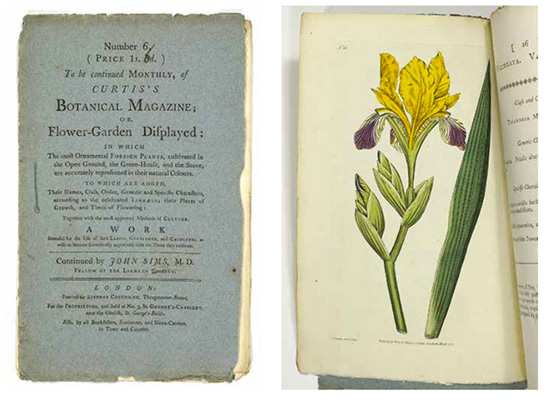
Curtis’s Botanical Magazine wrappers
Our Library contains all of the volumes of The Botanical Magazine / Curtis's Botanical Magazine from 1(1), 1787 up to the latest series 25(4), 2008, with scattered holdings after that date. The loose wrappers that we received from Wheldon & Wesley are not a complete set, but they begin with volume 1, number 1 (published in 1787) and end with volume 12, number 146 (published in 1839). We have photographed all of the printed text on the 405 individual wrappers, along with 45 printed inserts. We also have 17 duplicate wrappers, only two of which were photographed because they contain some different information on the inner or back pages.

Ellis, Directions (1770)
The Library has digitized John Ellis (?1710–1776), Directions for Bringing over Seeds and Plants, from the East Indies and Other Distant Countries, in a State of Vegetation: Together with a Catalogue of Such Foreign Plants as Are Worthy of Being Encouraged in Our American Colonies, for the Purposes of Medicine, Agriculture, and Commerce. To Which is Added, the Figure and Botanical Description of a New Sensitive Plant, Called Dionaea muscipula: or, Venus's Fly-trap (London, printed and sold by L. Davis, 1770).
Faber, [Mexicanarum Plantarum Imagines, ?1613]
In 1613 the young Accademia dei Lincei in Rome was attempting to publish the results of Francisco Hernández's expedition to New Spain (Mexico). While it would take almost another 40 years to finish the work, which they referred to as Tesoro Messicano but whose official title was Rerum Medicarum Novae Hispaniae Thesaurus (1651), the Lincei already had commissioned many of the botanical woodcuts they would use in the final publication. They printed some of these woodcuts for a potential patron of the Accademia and a lover of botany, the Prince-Bishop of Bamberg, Germany, Johann Gottfried von Aschhausen (1575–1622). Two members of the Accademia wrote dedicatory poems for Aschhausen, one in Greek by Luca Valerio (1552–1618) and one in Latin by Johann Faber, and a title page was added. They printed several copies of the little book. In 1958 Rachel Hunt purchased a copy of this rare work from a New York bookseller for her collection, and now the Library has digitized the book.
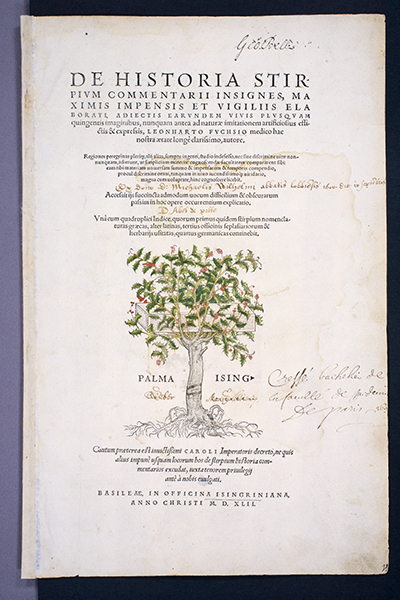
Fuchs, De Historia Stirpium (1542)
The Library has digitized Leonhart Fuchs (1501–1566), De Historia Stirpium Commentarii Insignes ... (Basel, In officina Isingriniana, 1542).
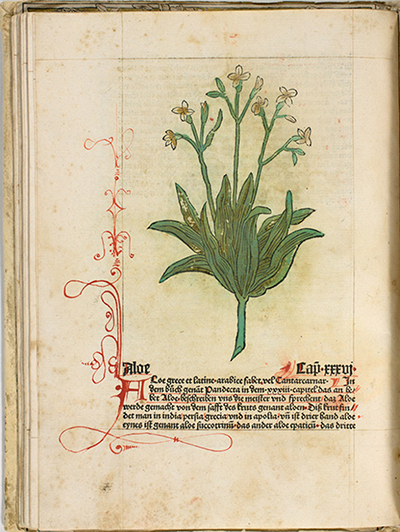
Gart der Gesundheit (1485)
The Library has digitized Gart der Gesundheit (Mainz, Peter Schoeffer, 1485).
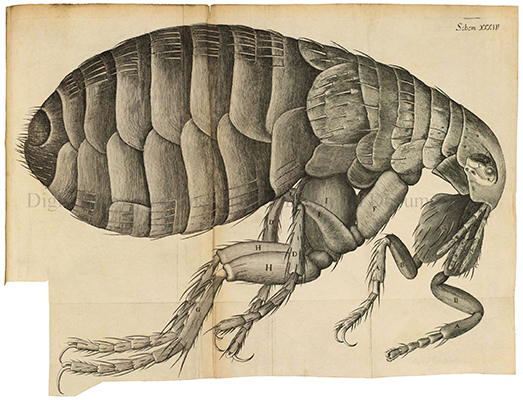
Hooke, Micrographia (1665)
The Library has digitized the plates for Robert Hooke (1635–1703), Micrographia, or Some Physiological Descriptions of Minute Bodies Made by Magnifying Glasses with Observations and Inquiries Thereupon (London, Printed by J. Martyn and J. Allestry, 1665).
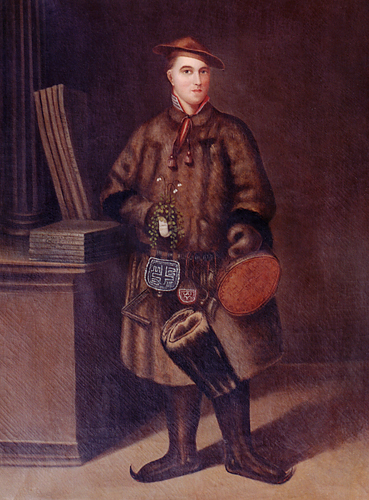
Linnaean Dissertations
There were 186 academic dissertations defended by students of Carolus Linnaeus (1707–1778) during the period 1743–1776. Our Strandell Collection of Linnaeana contains a complete set, and the Library is making them accessible online. Unlike the common practice today in which doctoral students write their own theses and defend them, in 18th-century Sweden the respondents typically expounded and defended the ideas of the praeses. Linnaeus served as praeses for 185 of the 186 dissertations, with Carl von Linné filius acting as praeses for the last one, Hellens' Hypericum. Thus what are usually referred to as the Linnaean dissertations are attributed to Linnaeus, even though they are also associated with the respondents who defended them and whose names appear on their title pages.
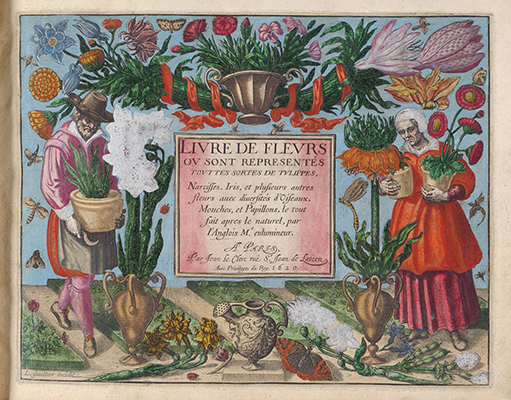
L’Anglois, Livre (1620)
The Library has digitized François L'Anglois (1589–1647), Livre de Fleurs, ou Sont Representés Touttes Sortes de Tulippes, Narcisses, Iris, et Plusieurs Autres Fleurs avec Diversités d'Oiseaux, Mouches, et Papillons, le Tout Fait apres le Naturel (Paris, Joan le Clerc, 1620).
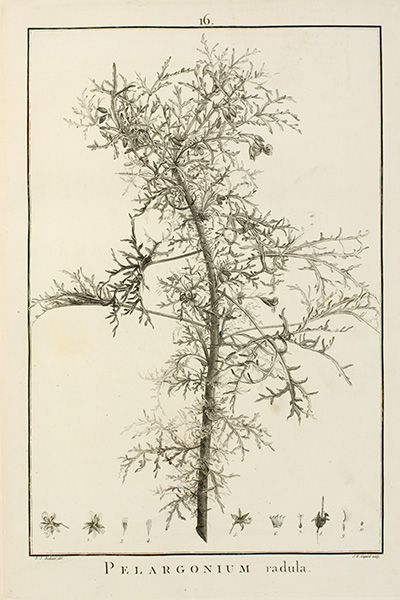
Redouté’s published work
Many people know the work of Luxembourg-born botanical artist Pierre-Joseph Redouté (1759–1840) primarily through the books that reproduce his work. Our founder Rachel Hunt collected many of his publications, and several additional titles were added to our Library after her passing. Rather than focusing on Redouté's well-known, large, floral books, we look at some earlier and less widely known publications. Seven examples are highlighted to discuss how some of his commissions and collaborations came about and to show different aspects of his artistic development.
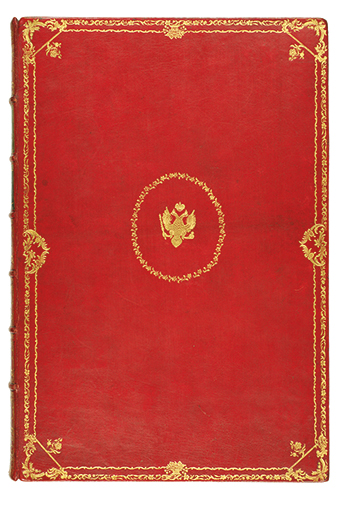
Royal armorial bindings
Before mass produced paperbacks and trade cloth bindings, book owners had their books bound privately. In Hunt Institute's Library covering materials range from the humble pastepaper to fine leather with gold tooling. There are those covered in a combination of leather and marbled paper, where the tougher leather is used on the spine and corners and the papers on the boards, and there are those covered in full leather or full parchment.
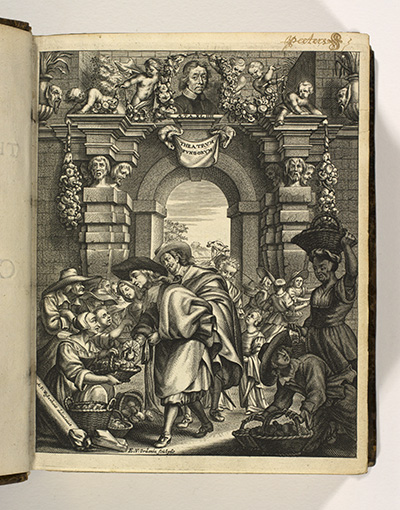
Sterbeeck, Theatrum Fungorum (1675)
Although for the most part we no longer collect mycological books for our Library, we hold in the historical literature the first book devoted solely to mycology, Francis van Sterbeeck's Theatrum Fungorum published in 1675, which we have digitized. Our copy of Theatrum Fungorum is unique in that, for nearly every uncolored engraved plate, there was bound next to it a watercolor copy of the same plate (not printed). The plates in the third part depicting plants do not have corresponding watercolors, so it appears our artist was not interested in painting them.
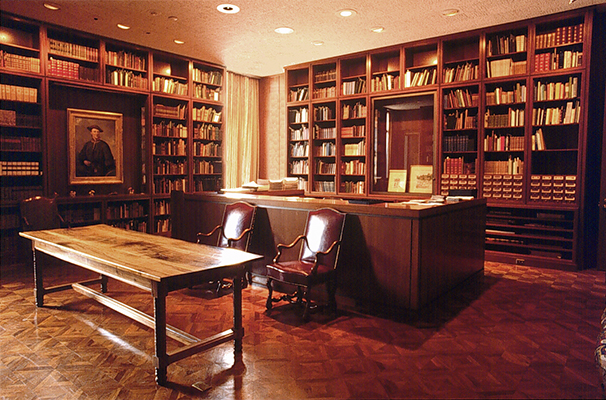
Strandell Collection
Curated by the Library, the Strandell Collection of Linnaeana includes nearly all published works, in almost every known edition and translation, by the great Swedish naturalist-physician Carolus Linnaeus as well as works by a number of his students and a considerable amount of commentary about Linnaeus and his natural history students, as published up to the late 1960s.
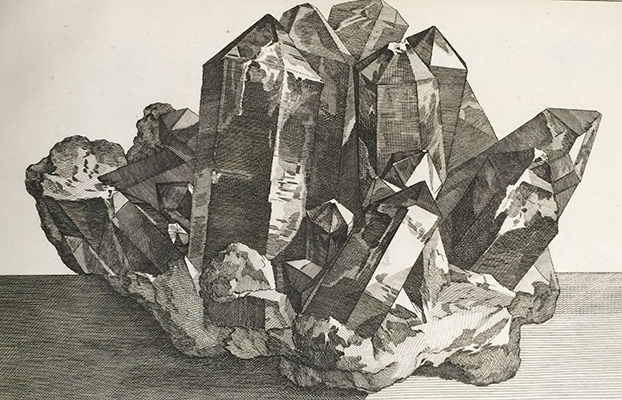
Three mid-18th-century catalogs of Swedish natural history collections
Carolus Linnaeus (1707–1778) was a busy man. In the middle of his very full career, while in the process of writing, editing and publishing some of his greatest works, as well as examining specimens, teaching at the University of Uppsala and maintaining an extensive correspondence, he also produced three catalogs of natural history "museums" for other collectors. These described collections of Count Carl Gustav Tessin (1695–1770), King Adolf Fredrik (1710–1771) and Queen Lovisa Ulrika (1720–1782).
[From left, probably Dianthus barbatus Linnaeus, Sweet William, and probably Silene dioica (Linnaeus) Clairville, Red campion, Caryophyllaceae], watercolors by an unknown artist from the 35 bound together with Dioscorides Pedanius (Anazarbos, A.D. ca.40–90), De Medicinali Materia Libri Sex ..., Johannes Ruellius (ca.1474–1537), ed., one of the earliest of the French botanists, with additions by Walther Hermann Ryff (fl.1539–1562) and Johannes Lonitzer (1499–1569) (Frankfurt, Chr. Egenolph, 1543); and Kreutter Buch des Hochberümpten Pedanii Dioscorides Anazarbei ..., transl. Johannes Dantz von Ast (Frankfurt am Main, Ciriaco Jacobizum Bart, 1546), HI Library call no. CA D594rl 543.
![Enlarge <p>[<em>From left</em>, probably <em>Dianthus barbatus</em> Linnaeus, Sweet William, and probably <em>Silene dioica</em> (Linnaeus) Clairville, Red campion, Caryophyllaceae], watercolors by an unknown artist from the 35 bound together with Dioscorides Pedanius (Anazarbos, A.D. ca.40–90), <em>De Medicinali Materia Libri Sex</em> ..., Johannes Ruellius (ca.1474–1537), ed., one of the earliest of the French botanists, with additions by Walther Hermann Ryff (fl.1539–1562) and Johannes Lonitzer (1499–1569) (Frankfurt, Chr. Egenolph, 1543); and <em>Kreutter Buch des Hochberümpten Pedanii Dioscorides Anazarbei</em> ..., transl. Johannes Dantz von Ast (Frankfurt am Main, Ciriaco Jacobizum Bart, 1546), HI Library call no. CA D594rl 543.</p>](/admin/uploads/hibd-dioscorides-demedicinali-dianthus.jpg)
